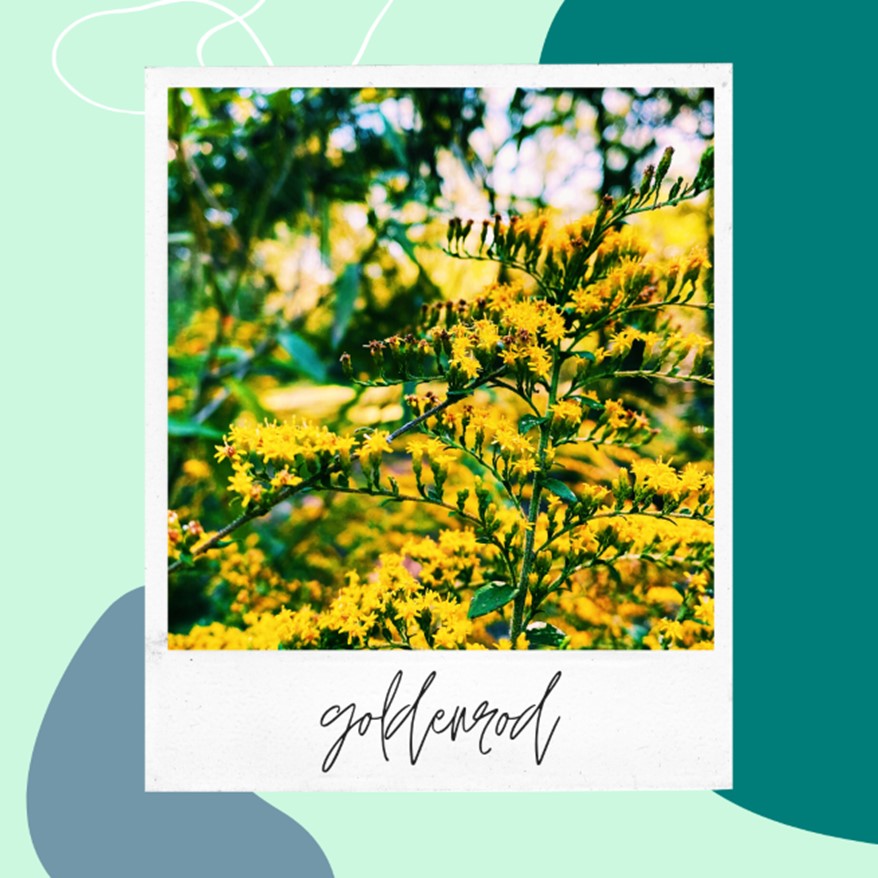
Download .pdf version
As temperatures lower and the days get shorter, many gardeners hang up their gloves and shovels for the cooler seasons. Pollinators, however, are still hard at work in SC, and they still need food and shelter to keep them energized and safe. One way to help pollinators in autumn is by including species like goldenrod that bloom during this season of harvest. Goldenrod is an herbaceous native perennial that begins to bloom in August, and pollinators love it. Several misconceptions plague goldenrod’s reputation. Some find that goldenrod looks too weedy for kept garden spaces and worry because it has invasive tendencies. Additionally, goldenrod often takes the blame for fall allergies. In actuality, goldenrod’s pollen is too heavy and sticky to be easily displaced by the wind. Hay fever is mostly caused by airborne pollen from plants like ragweed that bloom at the same time as goldenrod, serving as a testimony to not judge a flower by its petals!
More than two dozen species of goldenrod (genus Solidago) grow in SC—one, S. altissima, is SC’s state wildflower!—and many of these species make excellent additions to pollinator gardens. In the Richland Soil and Water Conservation District’s (RSWCD’s) demonstration garden, S. rugosa is making a scene this September.
S. rugosa is often referred to as “fireworks,” with vibrant golden flowers bursting from its stems and attracting the attention of pollinators in a garden space when most other plants have already gone dormant. The arching spikes spray out of 2-5’ tall stems, cascading over the bush with tiny flowers. The Latin genus name Solidago roughly translates to “whole healing ,” and refers to the plant’s medicinal properties, which may include an ability to reduce inflammation, relieve muscle spasms, and lower blood pressure. The specific epithet rugosa refers to the wrinkled leaves of the plant. Up until the late summer or early fall, this goldenrod presents as a deep green bush with wrinkled, toothed leaves. Because of this, S. rugosa is also referred to as wrinkle-leaf goldenrod or rough-leaf goldenrod.
S. rugosa thrives in gardens, meadows, or naturalized areas. The plant prefers full sun and slightly acidic, well-drained, and even poor soils. It can be difficult for this goldenrod to germinate from seed, so plant more seed to compensate. Because of its height, S. rugosa would best be placed towards the back border of a garden. While some species of goldenrod are incredibly vigorous and can have invasive tendencies, S. rugosa spreads more slowly and typically stays within five feet. Still, it may need to be divided eventually in a confined garden space as it naturally self-seeds and is rhizomatous, meaning that it has a subterranean stem called a rhizome. The rhizome stores extra nutrients for the plant, and this feature helps the plant to survive tough winters and other unideal weather conditions.
Though goldenrod may have a misleading reputation, its addition to a garden space will provide essential nectar and pollen resources for insects as they prepare for overwintering. Its golden blooms can be admired until October, highlighting the other yellows and reds of autumn. S. rugosa was selected as a variety for the RSWCD’s pollinator demonstration garden because of its beauty and pollinators’ love for the plant. The decision to add it to your garden space would be pure gold , too!
References: North Carolina State University, University of Wisconsin, Chicago Botanical Garden, Missouri Botanical Garden, United States Department of Agriculture
Download .pdf version
# # #
Conservation Districts are political subdivisions of state government under the local direction of five-member Boards of Commissioners. In South Carolina, Conservation District boundaries conform to County boundaries. The Richland Soil and Water Conservation District promotes the wise use and care of natural resources for long-term sustainability.
Contact
Richland Soil and Water Conservation District
2020 Hampton Street, Room 3063A
Columbia, SC 29204
Phone (803) 576-2080
Fax (803) 576-2088
E-mail soilandwater@rcgov.us
Facebook www.facebook.com/rswcd